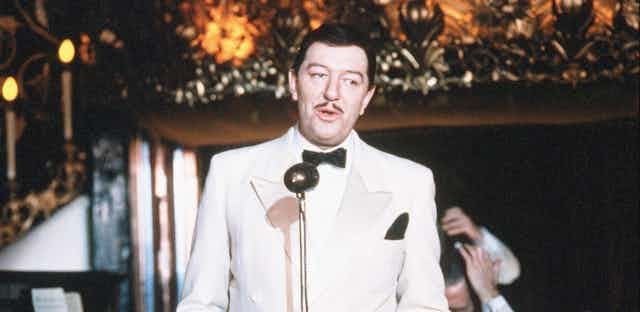Sir Michael Gambon, who died on September 28 at the age of 82, was a hugely versatile actor who enjoyed numerous and varied roles in film and television throughout the course of his long career.
Gambon was also a titan of the theatre. His major theatrical roles include Shakespeare’s Othello, King Lear and Falstaff, and Brecht’s Galileo, together with starring roles in works by the finest contemporary playwrights of his era: Beckett, Pinter, Churchill, Hare, Gray and Ayckbourn.
But the reality of theatre is that aside from newspaper cuttings of rave reviews and the fading memories of theatre-goers, very little record of these performances can actually survive for posterity. It is through film and television most audiences know Gambon and these are the media through which his image and presence will continue to circulate far into the future.

The acclaimed Singing Detective
Despite recent media obit headlines, Gambon was not just about Dumbledore and Harry Potter. Indeed it was another Potter – Dennis, not Harry – through which Gambon first became a household name. In 1986, he starred as lead character Philip Marlow in the TV playwright’s most successful and seminal work for BBC TV, The Singing Detective.
Covered in abrasive lesions and scales from a condition that also afflicted Potter in real life, Gambon’s wracked and hospitalised visage became an iconic part of 1980s British TV culture. The grotesque and tormented character in his hospital bed imagined doctors and nurses dancing all around him as they mimed to old 1940s big-band tunes.
But watch Gambon more carefully over the course of the six episodes and we get a masterclass in bravura performance. The serial could not have worked without Gambon at its core, making the audience believe in the character’s emotional journey from extreme despair and misanthropy, to more optimistic self-acceptance and a sense of equanimity at its close.
The serial’s director, Jon Amiel, insisted on Gambon for the role, knowing the actor would have the ability to embody not just Marlow’s rage but also, crucially, his vulnerability. This was vital for the audience to go on an emotional journey with the character, learning to peer behind all the anger, railing and self-loathing to the root causes that lay beneath.
And this is exactly we see. Amid all the flashbacks, fantasy sequences and musical numbers, it is Gambon to which the camera always returns as his eyes flash or his face tenses and another unwanted fantasy or forbidden memory begins to surface. It was a towering performance which would go on to win him the Bafta for best actor in 1987.
Swashbucklers, gangsters, aristos
The success of The Singing Detective divides Gambon’s TV and film career. Before that, he had acted in a range of plays for television in the heyday of the single play era when drama slots such as Play for Today (BBC 1970-84), ITV Playhouse (1967-83) and Play of the Month (BBC 1965-83) peppered the TV schedules.
But he also tried series acting, including an early part as a Scottish swashbuckler in 26 episodes of the 16th-century period drama, The Borderers, made for BBC Scotland between 1968 and 1970.
In 1985, Gambon took the title role in the three-part BBC2 serial Oscar, about the life of Oscar Wilde. This gained him critical praise and TV industry attention ahead of being cast in The Singing Detective. Soon Gambon’s screen acting career was flourishing as more television and cinema opportunities came his way.
Interestingly, there is often a division between his “rage” and “vulnerability” parts. In the former camp, there are Gambon’s coruscating turns as various species of gangster, beginning perhaps most memorably with his role as Albert Spica in director Peter Greenaway’s film The Cook, The Thief, His Wife and Her Lover (1989).

Here, we see extreme levels of rage and misanthropy as Gambon channels the utter despicability lying right at the heart of his character Spica’s name. By the end of the film, Spica embodies all the horrors of conspicuous consumption Greenaway clearly loathed about the 1980s.
If not quite as vivid in their depictions of pure evil, other memorable villain roles would follow, including a warmongering general in Toys (1992) and ruthless Irish rancher in the western Open Range (2003) – both made for Hollywood – as well as wealthy crimelord Eddie Temple in the hit British crime film Layer Cake (2004).

But in amongst the variety of gangsters and villains, not to mention haughty aristocrats in British period films such as Gosford Park (2002) and The King’s Speech (2010), we also see the more vulnerable side of Gambon’s characters, sometimes running parallel to the gruff exterior.
Older wiser characters
What pleased Gambon so much about being given the role of Dumbledore in the Harry Potter franchise (taking over from fellow Irish actor Richard Harris who died in 2002), was the recognition and affection from children the world over. And among his numerous television credits post-Dumbledore, we find similar traits of darkness and redemption within his Scrooge-like turn in a special episode of another family favourite, Doctor Who.
Though he retired from the theatre in 2015, Gambon continued to act in film and TV until just before his 80th birthday. It was that mesmerising combination of rage and vulnerability that always made him a compelling screen actor to watch, making audiences always care about the characters he inhabited.

Looking for something good? Cut through the noise with a carefully curated selection of the latest releases, live events and exhibitions, straight to your inbox every fortnight, on Fridays. Sign up here.

